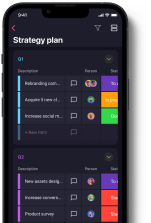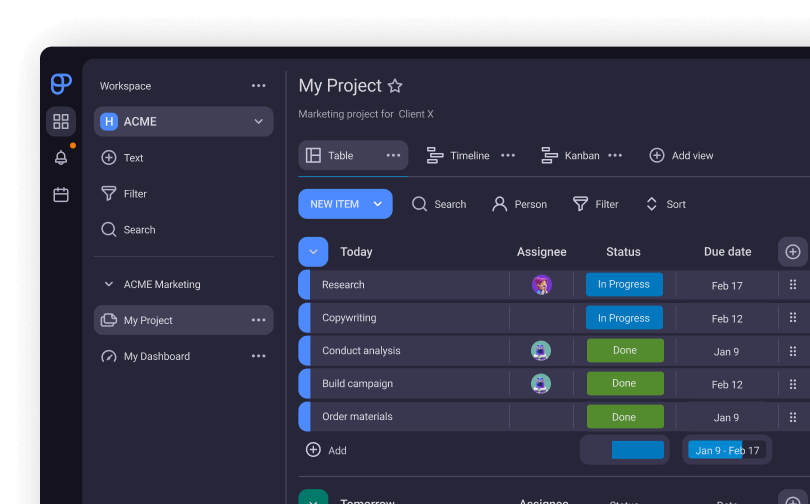Must-Know Project Management Statistics for 2024
You would think that projects are managed by certified project managers, who follow defined PM methodologies. That they don’t just use PM software, but go to great efforts to ensure they get the software that has all the features needed to support their workflow. That 1 project manager is in charge of 1 project and leads a large project team.
These were some of the assumptions that I held about project management at large — until I started looking at the statistics. The reality reflected through cold, hard stats, however, paints a different picture.

Table of Contents
10 most important project management statistics
To give you a taste of what’s to come, here are some of the most interesting and important statistics you should know about the state of project management in 2024:
- 53% of projects are run by non-certified project managers.
- While the average yearly salary for PMPs has increased by $7,000 in the last 3 years, it has gone down by $3,000 for non-PMP certified project managers.
- The number 1 challenge projects face are other projects — or rather organizations attempting to run too many projects at once.
- The difference in project success rates of organizations where leadership can make decisions in under 1 hour and those where this takes 5 hours is 40%.
- 42% of PMs don’t follow a defined project management methodology, which makes their projects 15% less likely to meet goals and stay within budget, and 16% less likely to get done on time.
- Fully remote, hybrid, and in-person project teams, have almost identical project performance rates (73.2%, 73.4%, and 74.6% respectively).
- Gymnastic enterprises — organizations that can successfully mix planning-oriented and agile approaches to project management — have higher project success rates across all metrics.
- 61% of project workers work remotely at least 1 day a week.
- Organizations that place high priority on soft skills are 8% less likely to lose budget to project failure, 12% less likely to experience scope creep, and 7% more likely to meet business goals.
- 82% of senior leaders plan on using AI in some capacity for project management in the next 5 years.
Statistics on project managers
The demand for project managers is so great at the moment that even non-certified PMs have no shortage of work.
Wellingtone’s The State of Project Management 2021 annual report shows that only 47% of projects are run by project management professionals, leaving the remaining 53% to be championed by non-certified PMs.
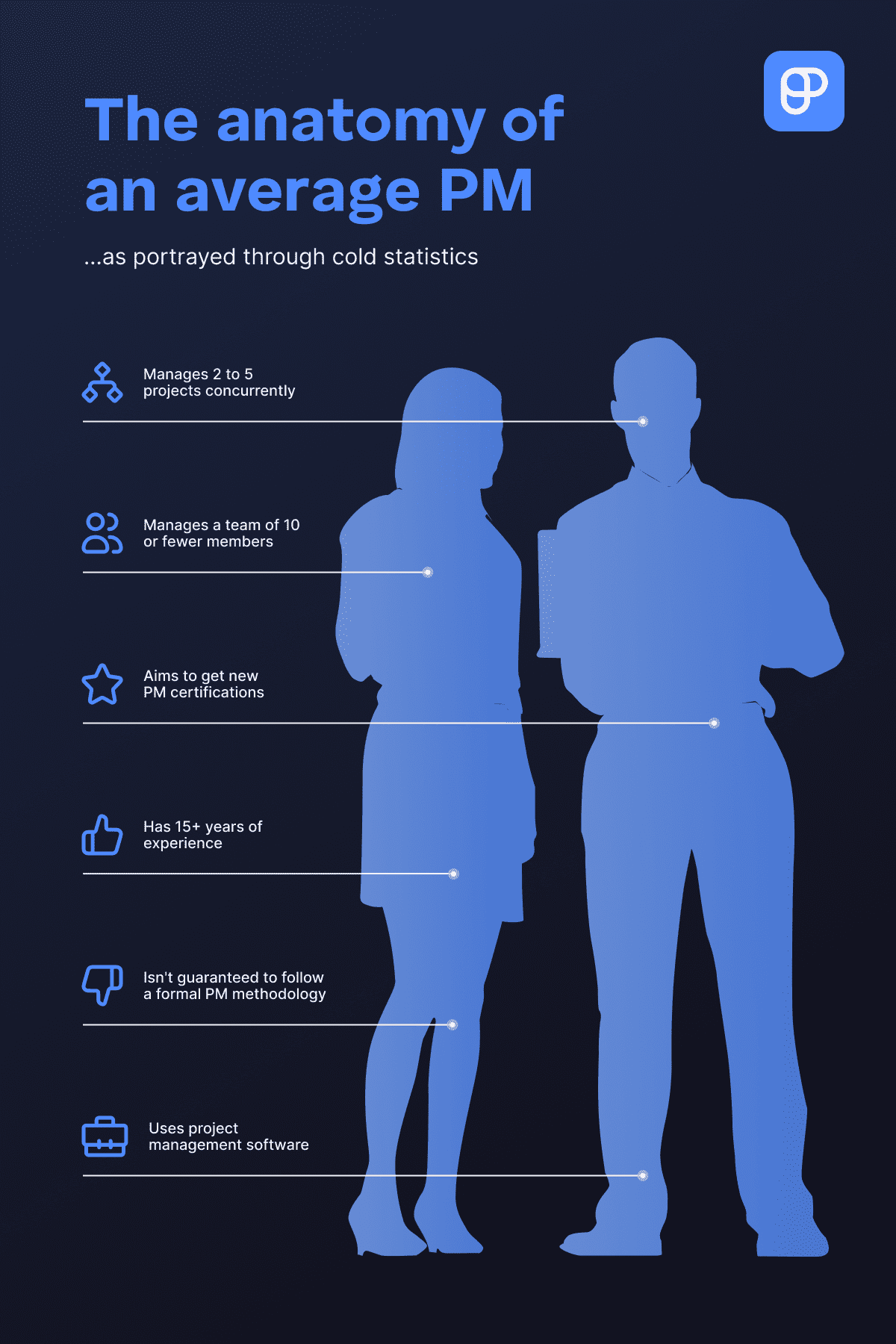
PMPs and non-certified PMs aren’t paid the same
- 66% of project managers reported increased compensation in 2023, with 61% of them reporting at least a 5% pay increase. This statistic is derived from PMI’s Project Management Salary Survey (13th Edition), whose survey respondents were mostly (78%) holders of the Project Management Professional (PMP) project management certification.
- The annualized salary difference between PMPs and non-PMPs in the US is 44%, with PMPs earning an average of $130,000 a year and non-PMPs earning $90,000. This gap has grown over the years, with it being at 32% back in 2021, according to PMI’s Project Management Salary Survey (12th Edition), when PMPs earned $123,000 and non-PMPs earned $93,000 in yearly salary.
- PMPs with less than 5 years of experience make, on average, $112,000 a year in the US. Those with 5 to 10 years of experience make $139,000. PMPs with more than 10 years of experience make $150,000. (Project Management Salary Survey 13th Edition)
PMPs and non-certified PMs have different career goals
- The top 3 career goals for project managers, according to the 2021 Project Management Report by RGPM, include: (1) acquiring a PM certification, (2) getting a new job, and (3) getting promoted.
- 35% of experienced PMs have contemplated leaving the profession. Among less experienced PMs, this percentage increases to 41%. (RGPM 2021)
- Only 47% of organizations have a clearly defined career path for PMs, according to PMI’s Pulse of the Profession 2020 report.
Most project managers work on multiple projects concurrently
- 59% of PMs manage anywhere between 2 and 5 projects at the same time, according to the 2021 RGPM report.
- Only 15% of PMs manage a single project at a time. (RGPM 2021)
- 15% of PMs manage more than 10 projects at the same time. (RGPM 2021)
Most project teams are small
- 70% of all project teams are composed of 10 or fewer members, according to the 2021 RGPM report.
- 53% of respondents from Wellingtone’s 2021 The State of Project Management report believe that even more work will be carried out by small informal teams in the future.
- Project managers who manage teams of 5 or fewer members earn $106,000 a year, according to the latest PMI salary survey. The salary increases to $120,000 for PMs who lead teams between 5 and 10 people; $125,000 for those leading teams of 10 to 15 people; $130,000 for those leading teams of 15 to 20 people; and $144,000 for PMs who lead teams of 20+.
The demand for project workers is growing, while the average age of project workers keeps increasing
- The number of project-oriented employees is expected to reach 102 million by 2030, according to PMI’s Talent Gap report. The global tally of project-oriented employees in 2019 was 90 million. Accounting for retirement, this projects a demand for 25 million project professionals across the 2020s.
- More than 40% of project workers have 20+ years of experience, according to AIPM and KPMG’s The state of project management in Australia 2022 report.
- 42% of respondents from the AIPM and KPMG study claimed that their organizations weren’t preparing for the oncoming mass retirement of experienced project workers by attracting new young talent.
- 69% of the 400 CEOs and business leaders polled in KPMG’s Keeping us up at night 2022 survey ranked talent acquisition, retention, and re/upskilling as the number 1 challenge.
Women in project management
PMI’s The State of Women in Project Management 2023 report shows the following:
- Men outnumber women 3 to 1 in project management.
- 20% of female project workers report taking part in management roles, compared to 23% of male project workers.
- Women earn less than men across the globe, with the average salary differential in the US amounting to 12%.
- The gender distribution discrepancy among project workers is smallest in healthcare (41% to 59%) and the largest in construction (13% to 86%).
- Women in project management are more likely to work as full-time employees rather than contractors.
- Women are 3.6% more likely to use agile approaches and 6.8% less likely to use waterfall approaches.
AI statistics in project management
- 82% of senior leaders state that AI will play a role in projects at their organization over the next 5 years, according to PMI’s Shaping the Future of Project Management With AI report.
- 21% of respondents from the 2023 PMI Annual Global Survey on Project Management claim to “always or often” use AI when managing projects.
- The typical cost reduction of AI automating job functions is estimated at 30% in Deloitte’s The Generative AI Dossier.
- Not all industries value AI as highly — KPMG’s 2023 Global Construction Survey shows that only 4% of engineering and construction firms are adopting AI across all projects; 36% are slowly implementing AI in just a few projects; an overwhelming 60% have not adopted AI at all.
- The potential ROI of artificial intelligence in construction is diminishing, from 17% in 2018 and 16% in 2021 to just 9% in 2023. (KPMG Global Construction Survey 2023)
Project management remote work statistics
Project management is stepping back from remote work, according to data from PMI’s Pulse of the Profession 2024 report.
- 61% of project workers reported working at least 1 day a week remotely in 2023, as compared to 89% in 2021. Admittedly, some industries were completely shut down at the height of the pandemic lockdowns, so the 2021 data is a bit skewed.
- Only 3% of project managers in construction work fully remotely, while 63% work fully in person (the highest percentage of any industry).
- In healthcare, only 18% of project managers work fully in person, while 35% work fully remotely (the highest percentage of any industry).
- The industry where most project managers work in hybrid locations are finances (64%), followed by telecommunications (51%), government (48%), and IT (48%).
Fully remote, hybrid, and in-person project management are equally effective
The Pulse of the Profession 2024 report shows that the perceived effectiveness of remote work is much lower in the eyes of senior leaders than project managers:
- 33% of project managers feel that remote work is as effective as in-person work.
- Only 25% of senior leaders feel that remote work is as effective as in-person work.
If we look at project performance statistics across the 3 types of work locations (remote, hybrid, and in-person), we see that the differences are marginal:
| Work location | Project performance rate |
|---|---|
| Fully remote | 73.2% |
| Hybrid | 73.4% |
| In-person | 74.6% |
Agile project management is in decline
Agile used to be the project management buzzword, but statistics from the Pulse of the Profession 2024 report show that it’s on the decline, being supplanted by hybrid approaches.
| Approach popularity in 2020 | Approach popularity in 2023 | |
|---|---|---|
| Predictive | 58% | 43.9% |
| Agile | 23% | 24.6% |
| Hybrid | 20% | 31.5% |
The definition of hybrid methodologies
If “predictive” and “Agile” are the polar opposite approaches, then everything in between them is some shade of “hybrid”. Consequently, the 2024 Pulse of the Profession report shows that hybrid project management isn’t identical in all companies:
- For 38% of companies, hybrid means mostly predictive with a bit of Agile components.
- For 37% of companies, hybrid means combining Agile and predictive components throughout the whole project.
- For 15% of companies, hybrid means mostly Agile with a bit of predictive components.
- For 8% of companies, hybrid means mostly Agile, but with predictive rollout.
Statistics on project management skills
PMs need an assortment of both hard and soft project management skills to do their job properly, but pragmatic PMs looking for work will focus on the ones organizations value the most:
| In-demand skills | How highly organizations value them |
|---|---|
| Technical skills | 68% |
| Leadership skills | 65% |
| Business skills | 58% |
| Digital skills | 50% |
Soft skills correlate with key drivers of project success
According to the PMI’s Pulse of the Profession 2023 report, the key drivers of project success are:
- High benefits realization management (BRM) maturity,
- Low levels of scope creep,
- Frequent use of standardized risk management practices,
- Frequent use of standardized stakeholder engagement practices,
- High organizational agility,
- High performance of department-specific/regional/divisional project management office (PMO),
- High project management maturity,
- Overall performance of enterprise-wide PMO,
- Project management success metric used: Quality of work, and
- Project management success metric used: Adherence to schedule.
Organizations that place a high priority on soft skills report higher key drivers of project success:
| Organizations that place high priority on soft skills | Organizations that place low priority on soft skills | |
|---|---|---|
| Report high BRM maturity | 57% | 18% |
| Report high project management maturity | 64% | 32% |
| Report high organizational agility | 51% | 16% |
| Meet business goals | 72% | 65% |
| Experience scope creep | 28% | 40% |
| Lose budget to project failure | 17% | 25% |
Statistics on Project Management Offices (PMOs)
According to Wellingtone’s 2021 report, the top 5 activities performed by most PMOs are:
- Project status reporting,
- Maintaining the project list/portfolio,
- Maintaining the PM methodology and document templates,
- Facilitating project approval process, and
- Project assurance.
In addition to project assurance, the 2 fastest-growing activities among PMOs are:
- Ownership of an enterprise PPM solution and
- Cross-project dependency management.
PMOs are becoming increasingly common but receiving fewer hires
That same 2021 Wellington report also showed that:
- Roughly 1 in every 4 PMOs had been opened in the 2 years prior to the release of Wellington’s 2020 report.
- 89% of organizations claim to have at least 1 PMO, with 50% claiming to have more than 1.
- In 2020, 57% of PMOs received new hires; in 2021, this number dwindled to 38%.
- The perceived value of PMOs dropped from 72% to 57% between 2020 and 2021.
Project management software statistics
- 39% of users cite the lack of a specific functionality as the leading cause of their dissatisfaction with certain software, according to Capterra’s Project Management Software Market Research Report.
- The 3 most important factors in choosing PM software are (in order): functionality, price, and ease of use. (Capterra)
- Only 10% of users demo 4 or more products to guarantee the software they purchase will have everything they need; 46% of users demo 2 products; 31% of users demo 3 products; 13% of users demo only 1 product. (Capterra)
- 69% of project managers use collaboration software, according to the AIMP and KPMG Project Delivery Performance in Australia 2020 survey.
- 50% of PM software is unable to track project KPIs in real-time, according to Wellingtone’s 2021 report.
PMs waste approximately 1 day each month manually sifting through data and compiling reports. (Wellingtone 2021)

Project management software feature usage breakdown
| Feature | Used by % of users who have access to it |
|---|---|
| Reports/dashboards | 65% |
| Document management | 64% |
| Collaboration | 60% |
| Requirements management | 57% |
| Budgeting | 55% |
| Resource planning | 54% |
| Time tracking | 53% |
| Feature | Not used by % of users who have access to it |
|---|---|
| Velocity charts | 34% |
| Gantt charts | 34% |
| Burndown charts | 34% |
| Risk management | 32% |
| Kanban boards | 30% |
| Project request intake form | 29% |
| Product roadmapping | 28% |
| Feature | % of users who want the feature but don’t have it |
|---|---|
| Gantt charts | 22% |
| Burndown charts | 21% |
| Automated workflows | 20% |
| Velocity charts | 20% |
| Portfolio management | 19% |
| Product roadmapping | 19% |
| Project request intake form | 19% |
Project management failure statistics
According to Wellingtone’s The State of Project Management 2020 report, the top 10 challenges projects face include:
- Attempting to run too many projects,
- Poorly trained project managers,
- Poor resource management,
- Ineffectively implemented PPM solution,
- Inconsistency in approach,
- Poorly trained project sponsors,
- Lack of planning skills,
- Poor risk management,
- Lack of appropriate software, and
- Lack of visibility of project status.
Decision latency affects project failure rate
- The success rate of projects where leadership can make decisions in less than 1 hour is 58%, according to ScrumInc’s study that links project failure and decision lag.
- When leadership drags out the decision-making process to 5 hours, project success rate plummets to just 18%. (ScrumInc)
Many PMs don’t follow formal methodologies
42% of PMs don’t follow a defined project management methodology, according to the 2021 report by Wellington. Those that don’t enjoy significantly lower project success rates.
| Projects with formal PM methodologies | Projects without formal PM methodologies | |
|---|---|---|
| Met goals/intent | 73% | 58% |
| Completed within budget | 63% | 48% |
| Completed on time | 59% | 43% |
The pandemic has negatively impacted businesses and staffing
- 80% of project management practitioners felt the pandemic has negatively impacted general business, according to PMI’s survey on the effects of COVID-19 on project management.
- 6% of qualified respondents from this survey lost their job due to the effects of the pandemic. (PMI COVID-19 Crysis)
- 20% of respondents reported feeling no negative impact. These were mostly in the IT/IS industry. (PMI COVID-19 Crysis)
- 73% of project professionals reported staff shortages according to the 2022 report by AIMP and KPMG.
- 52% of respondents reported suffering from delays in sourcing key roles or skills critical to projects. (AIMP and KPMG 2022)
The pandemic caused a short-term spike in project success rates
The short-term effect of the pandemic was a boost in project success — likely due to many projects being put on hold at that time — according to PMI’s 2021 Pulse of the Profession report:
| Pre-pandemic projects (2019) | Pandemic projects (2021) | |
|---|---|---|
| Met original goals | 68% | 73% |
| Completed within budget | 57% | 62% |
| Completed on time | 51% | 55% |
| Failed project, budget lost | 37% | 35% |
| Experienced scope creep | 37% | 34% |
| Deemed failures | 15% | 12% |
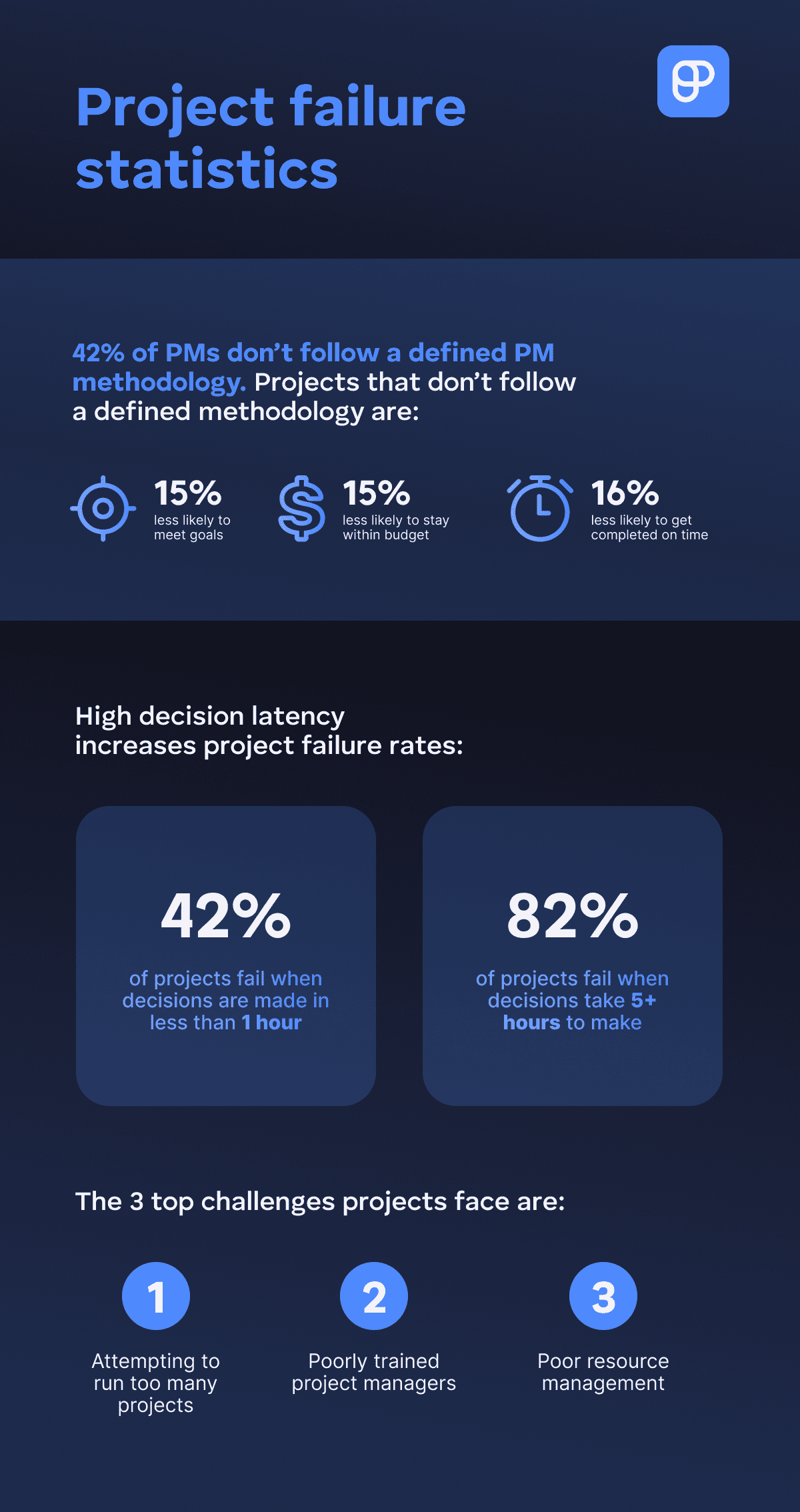
Statistics on project management in gymnastic enterprises
A common trend among best-performing organizations was discovered in the 2021 Pulse of the Profession PMI report, this being their outcome-focused attitude, unshackled by processes.
These organizations — dubbed gymnastic enterprises — were willing and able to effectively mix the planning-oriented approach of predictive enterprises with the iterative approach of agile enterprises.
Gymnastic enterprises fare better than traditional ones
| Gymnastic enterprises | Traditional enterprises | |
|---|---|---|
| Met original goals | 75% | 72% |
| Completed within original budget | 64% | 59% |
| Completed on time | 58% | 52% |
| Experienced scope creep | 33% | 37% |
| Failed project, budget lost | 36% | 37% |
| Deemed failure | 11% | 13% |
| Wasted investment due to poor project performance | 9% | 10.5% |
When asked how highly they prioritize different aspects of organizational culture, the following percentage of respondents answered with very high or somewhat high:
| Gymnastic enterprises | Traditional enterprises | |
|---|---|---|
| Is centered on delivering customer value | 80% | 65% |
| Is aligned with organizational values | 71% | 60% |
| Embraces digital solutions | 67% | 52% |
| Supports flexible work options | 66% | 52% |
| Fosters diversity, equity, and inclusion | 63% | 51% |
| Is receptive to change | 62% | 40% |
| Fosters innovation | 62% | 41% |
| Values project management | 52% | 42% |
| Values upskilling | 52% | 38% |
| Is attractive to next-gen project leaders | 45% | 34% |
Across the board, gymnastic organizations scored at least 10% higher when asked how highly their organizations valued the following:
| Gymnastic enterprises | Traditional enterprises | |
|---|---|---|
| Performance management | 58% | 44% |
| Learning and development | 56% | 44% |
| Workforce planning | 52% | 41% |
| Talent acquisition | 50% | 36% |
| Talent retention | 47% | 34% |
| Investing in youth | 45% | 32% |
| Fair compensation | 44% | 33% |
| Succession planning for key employees | 38% | 31% |
| Mentoring | 40% | 29% |
When asked which skills they consider most important for talent development, gymnastic enterprises doubled down on the following:
| Gymnastic enterprises | Traditional enterprises | |
|---|---|---|
| Collaborative leadership | 54% | 42% |
| Adaptability | 50% | 40% |
| Innovative mindset | 46% | 32% |
Improve project success rates with Plaky
While statistics make for fun trivia, they can also help point you in the right direction.
For example, Plaky checks all three of the most important factors when choosing PM software: functionality, price, and ease of use.
Functionality — Plaky offers ample task management and administration features, improves team collaboration and communication, and supports table, Kanban, and Gantt views.
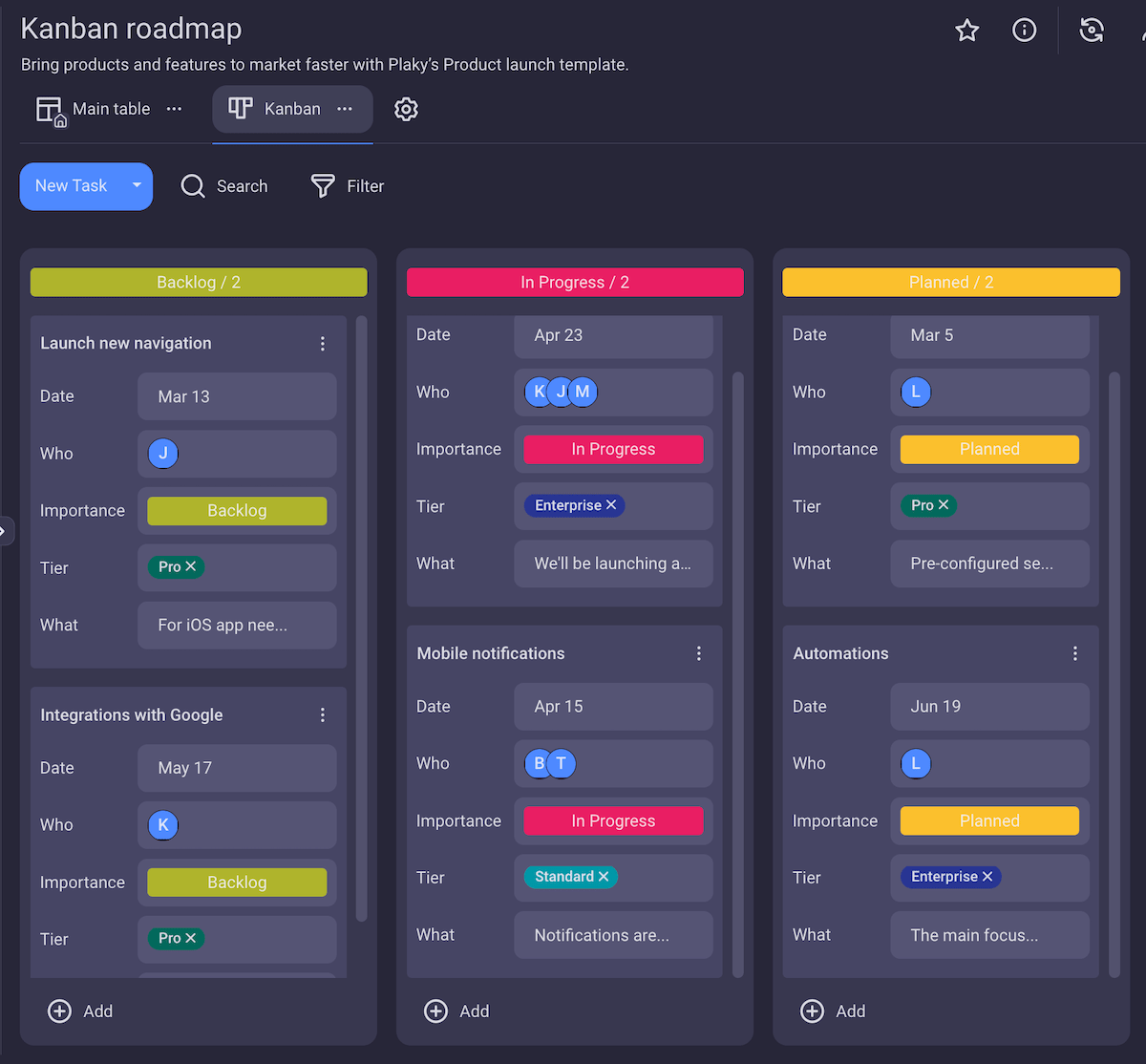
Price — most of Plaky’s features are free, including unlimited members and unlimited tasks. Advanced features, like the ever-divisive Gantt charts, are unlocked through Plaky’s approachably priced paid plans that start at a monthly price of just $3.99 per user.
For a detailed breakdown of what each plan offers, check out the Plaky pricing page.

Ease of use — Plaky is an intuitive and easy-to-use PM tool that has a shallow learning curve. While it’s completely customizable, it also offers plenty of free project management templates that teams can use to get started immediately. This makes Plaky a great pick even for project teams who aren’t tech-savvy.
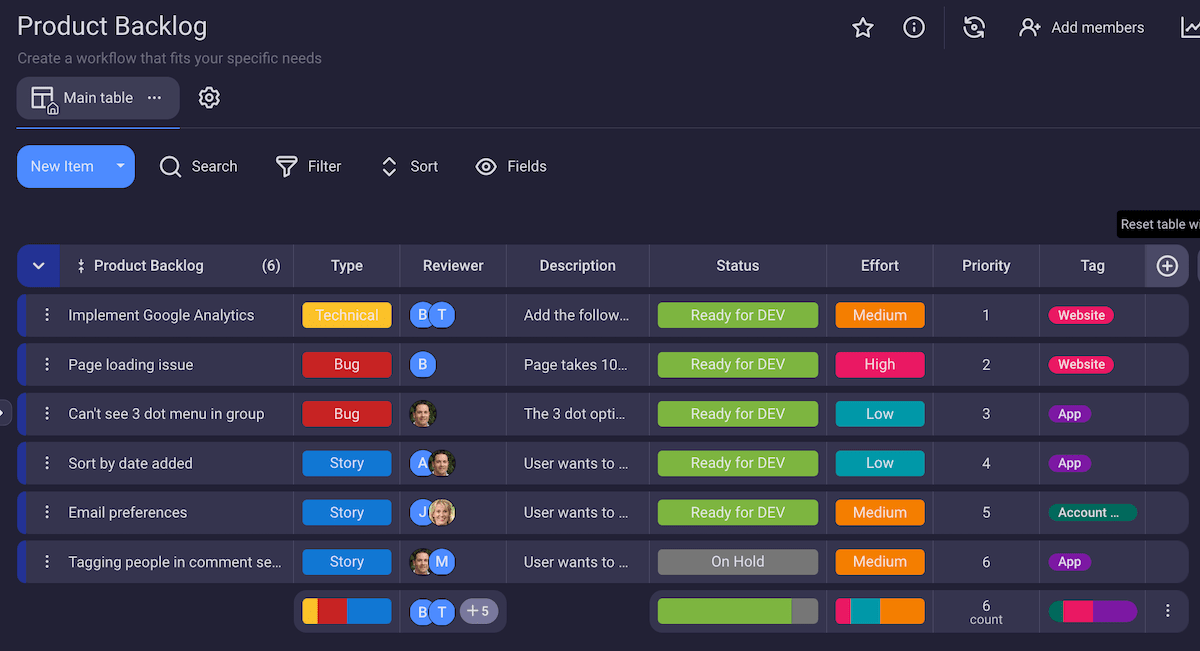
Ready to give Plaky a try? Sign up for Plaky’s free account today and give your project teams a statistical advantage in their project management endeavors.
 Project Management Hub
Project Management Hub 

